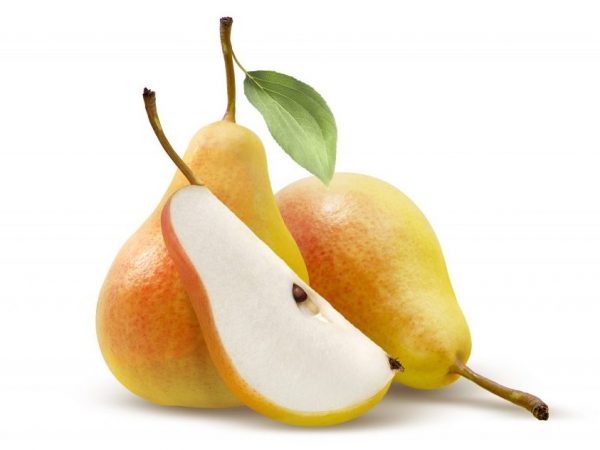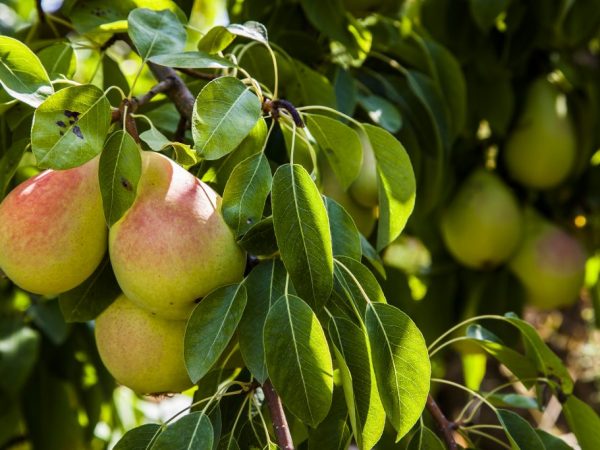Description of pear Severyanka
The Severyanka pear is also known under the name Red-cheeked, which stuck to it due to the interesting color of the fruit. The variety was bred in 1959 by breeders of the All-Russian Research Institute. Nowadays, it is widely grown in our country and collects a huge number of positive reviews.

Description of pear Severyanka
Characteristic
Judging by the description of the Severyanka pear, it got its name because of its resistance to low temperatures. It tolerates cold winters well, therefore it is widely grown even in the Urals and Siberia.
Trees begin to bear fruit at 2-3 years of age. The active flowering period begins at the end of April. The flowers are resistant to temperature extremes and cold weather. Severyanka, although considered self-fertile, bears fruit much better with the participation of pollinators, the best among which is the Pamyati Yakovlev variety.
The first fruits begin to ripen in early August. The yield increases every year: up to 100 kg of pears can be harvested from one adult tree.
The fruits have good taste, but quickly overripe and crumble. They are used to prepare various desserts and pastries, fruit salads and jams, and are also consumed raw. They also tolerate transportation well, but do not last long.
Description of the tree
The height of an adult tree does not exceed 5-6 m. Despite the average height, the plants grow actively in width. Many young shoots are formed on them every year. The crown is large enough (up to 6 m in diameter), has a pyramidal shape, close to round. The branches are of medium thickness, but strong enough.
The leaves are even, without bends, and are of medium size. Their surface has a deep dark green color and a beautiful glossy sheen. The flowers are white in color, collected in inflorescences (5-6), resembling the shape of saucers.
Description of fruits
Pear Severyanka Krasnoshchekaya has fruits with an interesting color. The main color is light yellow, but red spots and streaks appear in places where sunlight hits. Fruits are small in size and oval in shape. Their weight ranges from 80 to 120 grams.
The skin is thick and dense, while the pulp is quite juicy. Severyanka pears have a pleasant sweet and sour taste and a pronounced aroma.

Fruit weight ranges from 80 to 120 grams.
Benefits
The pear of the Severyanka Krasnoschekaya variety has a good reputation among gardeners, since it has a large list of positive qualities:
- frost resistance;
- unpretentiousness to growing conditions and care;
- excellent taste of fruits and versatility of their use;
- early maturity;
- resistance to many common diseases;
- high productivity;
- good transportability.
Landing
Planting is best done in autumn (September), or in April-May. To do this, it is necessary to choose seedlings no older than one or two years. The Severyanka pear variety needs good lighting, so for planting it is recommended to choose a sunny place on a hill, but with protection from the winds.
The planting hole is dug and prepared in a few weeks. It should be large enough: about 80 to 90 cm in diameter and 100 to 120 cm in depth. Loamy or clayey soil is ideal. A pre-prepared mixture of 200 grams is placed in the pit. superphosphate, three buckets of humus and 1 kg of organic matter.
The seedling is carefully lowered into the hole, avoiding damage to the roots. Then it is covered with soil, making sure that the root collar protrudes 5-6 centimeters above the soil surface. The soil is well tamped with feet and watered abundantly. It is also recommended to tie the young tree to a peg to avoid deformation of the trunk.

Planting is best done in autumn (September)
Care
Culture care is quite simple. The tree needs regular and abundant watering only for the first two months after planting and during active fruiting. The rest of the time, the number of watering can be slightly reduced, but care must be taken to ensure that the soil does not dry out, especially in the hot season.
An equally important step in the care is the correct pruning of trees. Since this species has a rapid formation and growth of shoots, they must be cut using a sparse-tiered method. The first pruning can be done from the second year of life.
Correct and timely fertilization of plants is also important. Top dressing should be done annually in the spring (before the buds begin to bloom). For this, phosphate and potassium fertilizers are used, as well as organic matter. In the summer, mineral dressings are carried out, and in the fall, humus is added.
It is necessary to regularly loosen the soil around the tree to improve air and water access to the root system. Young trees are covered for the winter to avoid freezing.
Possible diseases
Pear variety Severyanka has good immunity to many diseases, primarily fungal. They are not afraid of attacks of the moth and pear gall mite.
But plants affected by freezing can be affected by bacterial infections. In addition, their leaves can be affected by septoria. Among the pests dangerous for this variety, the hawthorn butterfly should be distinguished.
The description of the variety shows that it is necessary to carry out annual preventive spraying with colloidal sulfur, preparations that contain copper and use insecticides (against insect pests). It is also necessary to remove all weeds and regularly weed the area near the trees.
Conclusion
Summer pear Severyanka is one of the favorite varieties of residents of all regions of our country. Due to their frost resistance, seedlings successfully take root and grow even in cold regions. The fruit is ideal for processing, but not for storage. The variety pleases with its unpretentiousness and ability to adapt to conditions.

